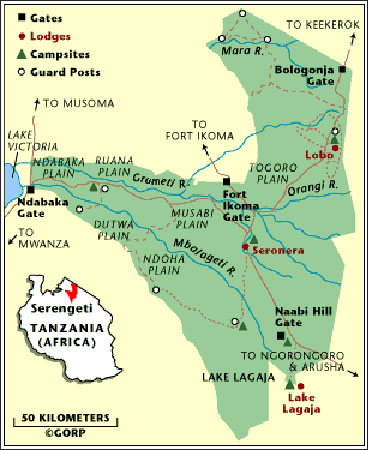The Serengeti is vast and beautiful; it's one of Africa's most captivating safari areas. The sheer amount of game here is amazing: estimates suggest up to about two million wildebeest, plus perhaps half a million zebra, hundreds of thousands of Thompson's gazelle, and tens of thousands of impala, Grant's gazelle, topi (tsessebe), hartebeest, eland and other antelope - all hunted by the predators for which these plains are famous.
Some of this game resides permanently in 'home' areas, which are great for safaris all year round. But many of the wildebeest and zebra take part in the migration - an amazing spectacle that's one of the greatest wildlife shows on earth. If you plan carefully, it's still possible to witness this in wild and remote areas.
The Serengeti National Park itself covers about 15,000km2 of mostly flat or gently rolling grasslands, interspersed with the occasional rock outcrops, or kopjes. But this is just the centre of a whole ecosystem which covers more than double that area, and includes Grumeti Reserve, Ikorongo Game Reserve, Loliondo Controlled Area, Maswa Game Reserve, part of the Ngorongoro Conservation Area and also Kenya's relatively small Maasai Mara Game Reserve. This combined area is often referred to as the Greater Serengeti area, or the Serengeti-Mara ecosystem.
Vast short-grass plains cover the south of Serengeti National Park, stretching into the north of Ngorongoro Conservation Area, the south-west Loliondo and Maswa Game Reserve. Occasionally there are small kopjes which, like the forests around Lake Ndutu, harbour good populations of resident game. However, around these oases of permanent wildlife, the majority of this area is flat and open. It's alive with grazing wildebeest from around late-November to April, but can be very empty for the rest of the year. Places to stay here include
In the heart of the national park, just to the north of the short-grass plains, Seronera has all the best features of the Serengeti and also, sadly, its worst. Scenically, it's a lovely area - with open plains, occasional kopjes and lines of hills to add interest. The resident game here is phenomenal, with high densities of relaxed leopards, cheetah and lion. These live off the resident herbivores, as well as the migrating game. The migration passes through here in April/May, but Seronera is within reach of both the Southern Plains and the Western Corridor - so from about November to June, it can be used as a base to see the migration. Seronera's big drawback is that it is always busy; places to stay include:
Stretching to the west, almost to Lake Victoria, the Serengeti narrows into what's known as the Western Corridor. The key feature of this area is the two rivers, the Grumeti and the Mbalageti, which run almost parallel, each supporting a band of most, evergreen riparian forest. This area sustains a very good permanent game population, including plenty of zebra and wildebeest, all the predators and forest 'specialists' like colobus monkeys. The birdife is particularly varied. The migration passes through between about May and July - pausing to gather momentum before crossing the crocodile-rich waters of the Grumeti River, into the Grumeti Reserve. Camps in the Serengeti's Western Corridor include:
Stretching from Seronera for about 100km north, to the Kenyan border, the northern Serengeti is gently rolling country, broken by small rivers and occasional hills and kopjes. There are good permanent populations of wildlife in several areas here, including the very beautiful Lobo Kopje. It's interesting, varied country that's far from the park's main entry point in the south - and hence it receives delightfully few visitors. The further you go north, the fewer vehicles you see. Even when the migration is here, between about August and October, you can still enjoy spectacular crossings of the Mara River. A particularly stunning are is the wild Lamai Wedge - the area of land between the Mara River and the Kenya Border - which includes the picturesque Wogakuria Kopjie, and a beautiful series of game-rich valleys and plains. This is the only area of the national park where off-road driving is acceptable. Here, we suggest you stay at:
Singita Grumeti Reserves covers almost 1,500km 2 of private reserves which run along the north side of the Western Corridor. Within this are three, very different luxury lodges. All offer unrivalled exclusivity for watching the migration as it journeys north, and recycle all of their profits into local conservation and community development initiatives.
West of the Serengeti National Park, between the Ngorongoro Conservation Area and the Kenyan border, lies Loliondo game Controlled Area - an area belonging to the Maasai tribes that live there. The western side of this, beside the park, is very much part of the Serengeti's ecosystem; it has much resident game and the migration passes through here as well.
There are a few camps here which have the flexibility to offer night drives and walks, often using Maasai guides - and visits to local Maasai villages. Around about October and November, there's a good chance to see part of the migration here, as it returns south.
Sadly, the Serengeti doesn't always live up to its potential. It's easy to end up with a herd of vehicles around you, destroying any sense of wilderness. It's tempting to opt to rush around on dusty, corrugated roads with little time to stop. It's also easy to simply miss the migration, which isn't nearly as predictable these days as many will tell you.
Because of this, planning a safari here can be complicated; we need to guide you to choose the right camps at the right time of year, and get the best experience possible - especially when the wildebeest migration does vary every year.
